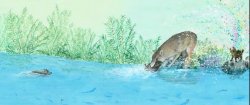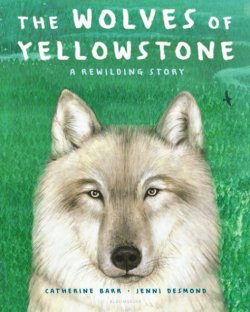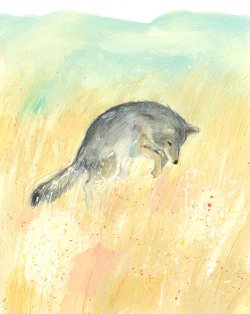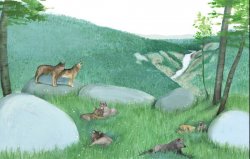
Artwork by Jenni Desmond from The Wolves of Yellowstone
© 2019 by Bloomsbury Children’s Books


Reviewed By Samantha Piede
If fairytales and gothic horror stories are to be believed, wolves are gobblers of pigs, grandmothers, and little boys who lie. They scheme and deceive, misdirecting little girls to take the wrong forest path with the aim of predation. Wolves are rarely painted as heroes. Adult language, too, has taken on the same moralistic bent. We tell others to look out for “wolves in sheep’s clothing,” and it is understood that to call a colleague “wolfish” is anything but a compliment. It doesn’t help matters that, in life, a wolf’s carnivorous diet can find them at odds with human interests. In times when food in the wild is scarce, they are found scavenging from chicken farms and cattle ranches, literally eating into owners’ livelihoods. From this vantage point, a wolf is an inconvenience at best and a menace at worst. Taken together, these images have fostered Western culture’s adoption of wolves as symbols of threat: an ironic posture, given that, in 1974, human interventions had cut such a swathe through gray wolf populations that the species became protected under the Endangered Species Act.
The stock image of wolves as predators is an incomplete picture. To delimit wolves to ‘simply’ being predators fails to take a wider view and consider their role in larger ecosystems. This is where the work of alternate stories may prove valuable in fleshing out ways that species that seem threatening can also serve fundamental roles in maintaining the planet. In The Wolves of Yellowstone: A Rewilding Story (2022), children’s book author Catherine Barr and illustrator Jenni Desmond help young readers visualize the gray wolf’s role as a keystone species in Yellowstone National Park: one whose presence is essential to the survival and flourishing of other species in its environment.
The book details the role that the US government played in wolf extermination in the early 20th century. The opening pages tell readers that “park rangers shot the last wolf in Yellowstone in 1926,” thus eliminating all wolves in that environment. Yet, this did not have the beneficent effects the government expected. Barr reveals that, without wolves, “the park changed…” No longer facing natural predators, the park’s elk population exploded. With the influx of many more hungry mouths, foliage diminished. Barr writes, “Without wolves, the elk ate and ate and ate. They ripped up grass and tore down leaves. They nibbled the young shoots that lined the riverbanks, so fewer new trees grew. The once lush grasslands became barren and brown.” This, in turn, had a rippling effect on the park. With fewer trees came fewer nesting sites for birds and fewer building materials for beavers. The park’s ecosystem was slowly collapsing. However, in 1995, after a “twenty-year battle between government officials, lawyers, scientists, and conservationists,” wolves were once again reintroduced to the park. Conservationists, in conjunction with the Canadian government, began trapping wolves from the Canadian Rockies and releasing them in Yellowstone, stimulating a slow transformation of the environment.

Artwork by Jenni Desmond from The Wolves of Yellowstone
© 2019 by Bloomsbury Children’s Books
Barr’s writing helps readers make connections between the wolves’ reintroduction and the park’s subsequent rejuvenation. In describing the elk, she tells readers that, due to overpopulation, “there is not enough food to fill their bellies – the elk are weak and hungry.” However, wolves present a solution: “Wolves need to eat, and wolves eat elk.” Barr demonstrates that pruning the herd is also a boon to the elk; fewer mouths to feed means a healthier, better-fed population. Simultaneously, other species directly benefit as well. For instance, wolves often hunt more than they need, leaving scraps for the park’s scavengers. “Hungry wolf packs leave plenty of leftovers,” writes Barr. “[H]ungry bears seek and scrounge these wolf-killed carcasses across the park.
The Wolves of Yellowstone demonstrates that the impact of these actions accrues over time. As elk move around to avoid the packs, the land recovers from over-grazing. New trees take root: “Willow, aspen, and cottonwoods reappear along the edge of the rivers, their strong roots stretching deep into the rich soil below.” With new trees, in turn, come building materials for nests and dams, and the thriving flood planes create “new watery habitats.” The rivers themselves also begin to straighten, and the riverbanks “collapse less often.” Slowly, the park is restored; its elements are once again in balance.
One further feature of Barr’s text is that the characterization of the wolves pushes against their pop culture depictions. In describing the packs, the book also mentions wolf pups, described as standing “on wobbly legs” after trying to cross a stream and shaking off “rainbows of water droplets on the opposite bank.” Such descriptions remind readers that wolves also must nurture their own delicate offspring, which are just as helpless as any other animal at that age. “If hunting is poor or if other predators snatch the pack’s prey,” Barr reminds us, “then the pups will starve.” Likewise, Desmond’s illustrations often feature images of wolves cuddled up next to one another in a valley, their pups rolling around the grasslands in play. Children’s literature is already replete with imagery of wolves as villains. These images offer a sharp contrast to the way wolves are typically portrayed in children’s literature and pop culture more broadly.

Artwork by Jenni Desmond from The Wolves of Yellowstone
© 2019 by Bloomsbury Children’s Books
Recognizing this ‘tightness’ also raises questions about nature’s tendency towards self-correction. Keen readers may notice that, when all components of an ecosystem – wolves, elk, grass – are available, these elements keep one another in check. For instance, when grass becomes scarce, herbivore populations decline, tipping the system back into balance. Students may be invited to think their way through the role of balance in complex natural systems: how the system maintains itself when all of its pieces are present.
Though the book presents its narrative in an uplifting format, it does not do so at the expense of realism. Many books on rehabilitation, especially those written for children, will shroud the details of the rewilding process in evasive language, but The Wolves of Yellowstone does not mince words. Barr is upfront about scientists’ use of tranquilizer darts to capture Canadian wolves and the multiple weeks the wolves spent in pens in order to disrupt their “natural homing instinct” that could drive them back north. She also acknowledges that the decision for rewilding was not universally lauded. “Wolf wars still rage,” she tells us; rewilding has remained unpopular with many local ranchers. Ranchers too must make a living. Yet, she also points out, “humans too depend on a healthy natural world to survive.” The decision to keep these elements in the tale opens opportunities for students to consider the ethics of the endeavor: its benefits and its losses. Educators may ask students to consider the tradeoffs of an endeavor like rewilding. What acts they are willing to allow or disallow in an attempt to balance an ecosystem? What benefits should they prioritize? What costs are they willing to endure? And why do they come to these conclusions?
The Wolves of Yellowstone makes space for young readers to explore the implications of our various natural connections and to complicate our cultural assumptions about wolves. Perhaps even frightening creatures have something to give – or perhaps they shouldn’t be frightening at all.

Artwork by Jenni Desmond from The Wolves of Yellowstone
© 2019 by Bloomsbury Children’s Books